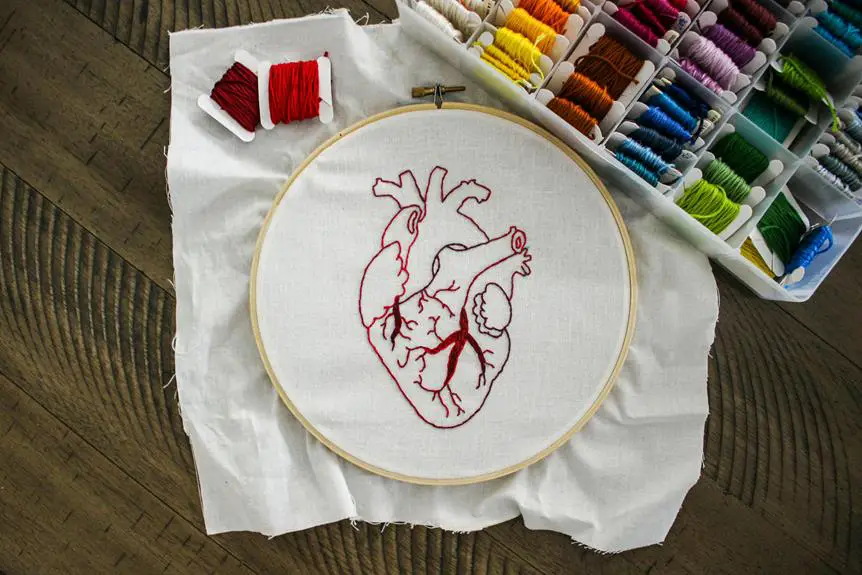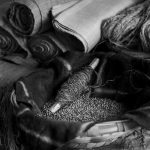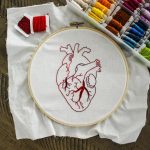As you consider the versatile and durable fabric known as poly tricot, you might wonder what goes into creating it. The manufacturing process is quite intricate, involving several stages that transform raw materials into a high-quality fabric. You start with the selection of synthetic fibers like polyester, nylon, or spandex, chosen for their exceptional strength and elasticity. But how do these fibers get transformed into a soft and textured surface? That's where the process of extrusion, texturizing, and weaving or knitting comes in – but what specific steps are involved, and how do they impact the final product's performance and appearance?
Table of Contents
Raw Material Selection
When selecting raw materials for poly tricot production, you'll typically choose from a range of synthetic fibers, such as polyester, nylon, or spandex, which offer the necessary strength, durability, and elasticity for this type of fabric. These fibers are often preferred over natural fibers like cotton or wool because they can withstand the high temperatures and tensions involved in the poly tricot manufacturing process.
You'll also consider the specific properties you want your poly tricot fabric to have, such as moisture-wicking, breathability, or UV resistance. This will help you narrow down your fiber selection. For example, if you want a fabric with high elasticity, you may choose a spandex-rich blend. If you need a fabric with excellent moisture-wicking properties, you may opt for a polyester-based blend.
In addition to fibers, you'll also select other raw materials, such as chemicals, dyes, and finishes, which will affect the final appearance, feel, and performance of your poly tricot fabric. By carefully choosing your raw materials, you'll be able to create a high-quality poly tricot fabric that meets your specific needs and requirements.
Extrusion of Polyester Fibers
As you move forward in the poly tricot manufacturing process, you'll need to understand how polyester fibers are extruded. You'll be working with an extruder machine, which plays a crucial role in shaping the fibers into the desired form.
To get started, let's break down the fiber production process and explore how the extruder machine operates.
Fiber Production Process
You'll start the fiber production process by extruding polyester fibers, which involves forcing molten polyester through a spinneret to create long, thin fibers. The spinneret is a metal plate with tiny holes that shape the fibers. As the molten polyester passes through the spinneret, it cools and solidifies, forming fibers with a uniform thickness.
As the fibers exit the spinneret, they're cooled and stretched using a process called drawing. This process aligns the molecular structure of the fibers, giving them strength and elasticity. You'll control the speed of the drawing process to achieve the desired fiber properties.
The drawn fibers are then wound onto spools or cut to a specific length, depending on the intended use. You'll also apply a finisher to the fibers to give them the desired texture and appearance. The finished fibers are now ready for the next stage of the manufacturing process, where they'll be woven or knitted into poly tricot fabric. By controlling the extrusion and drawing processes, you can produce fibers with specific properties, such as softness, strength, or wrinkle resistance.
Extruder Machine Operation
Operating the extruder machine is the first critical step in producing high-quality polyester fibers for poly tricot fabric, requiring precise temperature and pressure control to ensure a consistent melt flow.
You'll need to carefully monitor the machine's temperature, pressure, and screw speed to prevent overheating, which can damage the fibers. The extruder machine uses a combination of heat and pressure to melt the polyester pellets, which are then forced through a spinneret to create the fibers.
As you operate the extruder machine, you'll need to adjust the temperature and pressure settings to achieve the desired fiber properties. You'll also need to check the machine's screw and barrel for wear and tear, as this can affect the quality of the fibers.
Regular maintenance is crucial to ensure the machine runs smoothly and efficiently. By carefully controlling the extruder machine's operation, you can produce high-quality polyester fibers that meet the required specifications for poly tricot fabric.
This is a critical step in the manufacturing process, as it directly affects the final product's quality and performance.
Texturizing the Polyester Yarn
Someone is assigned to thread the textured polyester yarn into a series of interlacing spindles on a texturizing machine. This process is crucial in creating the textured effect that poly tricot fabric is known for. As you thread the yarn, you'll notice that the machine is designed to twist and turn the fibers in a specific way, creating a textured surface.
Next, you'll set the texturizing machine to the desired settings, taking into account the type of poly tricot fabric being produced. The machine will then begin to twist and interlace the yarn, creating a series of loops and curls that give the fabric its texture. You'll need to monitor the machine closely to ensure that the yarn is being texturized evenly and to the correct density.
As the texturizing process continues, you'll start to see the poly tricot fabric take shape. The textured yarn will begin to resemble the final product, with its characteristic softness and drape. Your role is to ensure that the texturizing machine is running smoothly and that the yarn is being processed correctly. By doing so, you'll be helping to create high-quality poly tricot fabric that meets the required standards.
Weaving or Knitting the Fabric
Now that you've got your texturized polyester yarn, it's time to turn it into a fabric.
You'll need to decide whether to weave or knit the yarn, as each technique produces a distinct type of poly tricot fabric.
As you explore the weaving process and knitting techniques used in poly tricot production, you'll learn about the specific methods and machinery involved.
Weaving Process Explained
When weaving poly tricot, you'll typically start by creating a fabric with a specific texture and pattern using either a rapier or air-jet loom, which can weave the yarns at high speeds and with great precision.
These looms are designed to handle the unique properties of poly tricot yarns, which are often made from synthetic materials like polyester or nylon.
As you set up the loom, you'll need to consider factors like yarn tension, weave density, and fabric width to achieve the desired texture and pattern.
Once the loom is set up, you'll begin the weaving process by passing the warp yarns through the loom's shed, which is the opening between the upper and lower warp yarns.
The weft yarns are then inserted through the shed, creating a series of interlocking loops that form the fabric.
The loom's precision and speed allow for a high level of control over the weaving process, enabling you to create complex patterns and textures with ease.
Knitting Techniques Used
Most poly tricot fabrics can be created using either weaving or knitting techniques, with the choice between the two depending on the desired texture, flexibility, and overall performance of the final product.
When you opt for knitting, you'll be using needles to create rows of interconnected loops. This technique allows for greater flexibility and elasticity in the fabric, making it ideal for applications where stretch is essential, such as in activewear or hosiery.
As you knit the poly tricot fabric, you'll be using a specific type of knitting machine that's designed to handle the unique properties of polyester fibers. The machine will create a series of interlocking loops that give the fabric its characteristic texture and flexibility.
You can adjust the knitting pattern, yarn weight, and needle size to achieve the desired thickness, density, and texture. Knitting also allows for the creation of complex patterns and designs, making it a popular choice for fashion fabrics.
Finishing Treatments Application
You'll apply various finishing treatments to the poly tricot fabric to enhance its performance, appearance, and durability.
These treatments can include softening, calendaring, or sanforizing to give the fabric the desired texture and stability. Softening treatments, like napping or shearing, will help to raise the fibers and create a softer, more plush surface.
Calendaring involves passing the fabric through heated rollers to smooth and flatten it, while sanforizing shrinks the fabric to prevent further shrinkage in the finished product.
You may also apply chemical treatments to improve the fabric's wrinkle resistance, stiffness, or water repellency. For example, a fabric finisher might apply a fabric softener or a wrinkle-resistant coating to the poly tricot fabric.
Additionally, you can apply treatments to reduce pilling or fraying, such as a fabric stabilizer or a pill-resistant coating. These finishing treatments can be applied using various methods, including padding, spraying, or exhaust techniques.
Dyeing and Printing Processes
After enhancing the fabric's performance and appearance with finishing treatments, the poly tricot fabric is now ready for dyeing and printing processes that will add color, patterns, and unique designs to its surface.
You'll notice that the dyeing process involves immersing the fabric in a dye bath, where it's treated with a specific temperature, time, and chemical composition to achieve the desired color. The type of dye used depends on the intended color and the fabric's properties.
Once the dyeing process is complete, the fabric may undergo printing processes to add patterns, designs, or logos. Various printing techniques can be used, such as screen printing, rotary printing, or digital printing, depending on the design complexity and production volume.
The printing process involves applying ink or dye to the fabric using a specific pattern or design. Techniques like discharge printing or resist printing can also be used to create unique effects.
Final Quality Control Measures
As the poly tricot fabric exits the dyeing and printing processes, it's crucial to implement rigorous final quality control measures to ensure the product meets the required standards and specifications. You'll want to inspect the fabric for any defects, such as uneven dyeing, misprinted patterns, or fabric damage.
Here's a checklist of quality control measures you should consider:
| Quality Control Measure | Description | Acceptable Standards |
|---|---|---|
| Fabric Inspection | Visual inspection for defects | No visible defects or damage |
| Color Fastness Test | Test for color bleeding or fading | Meets ISO 105-E01 standards |
| Dimensional Stability Test | Test for shrinkage or stretching | Meets ISO 5077 standards |
| Tensile Strength Test | Test for fabric strength and durability | Meets ISO 13934-1 standards |
Frequently Asked Questions
Is Poly Tricot Fabric Suitable for Outdoor Use?
You're considering using poly tricot fabric outdoors, but its suitability depends on several factors. It's lightweight, breathable, and quick-drying, making it ideal for outdoor activities. However, it may not be durable enough for harsh weather conditions.
Can Poly Tricot Be Used for Medical Applications?
You might be wondering if poly tricot's moisture-wicking and quick-drying properties make it suitable for medical applications. You can consider its hypoallergenic nature and ability to be easily sterilized, but its suitability depends on the specific use case.
Is Poly Tricot Fabric Prone to Pilling or Snagging?
You'll find that poly tricot fabric can be prone to pilling or snagging, especially if it's not made with high-quality materials or woven tightly enough. However, some manufacturers use special treatments to minimize this issue.
Can Poly Tricot Be Recycled or Reused?
You can definitely explore eco-friendly options with poly tricot. Since it's a synthetic fabric, you might be able to recycle it or reuse old poly tricot items, like upcycling old clothes into new accessories or repurposing fabric scraps.
Does Poly Tricot Fabric Have Any Antibacterial Properties?
You're wondering if poly tricot fabric has antibacterial properties. While it's not inherently antibacterial, some poly tricot fabrics can be treated with antimicrobial finishes that inhibit bacterial growth, making them suitable for activewear and medical applications.
- Fabrication of Kevlar Parts: French Applications and Costs - June 21, 2025
- Manufacturing With Glass and Kevlar: Spanish Guide to Composite Uses - June 21, 2025
- Fabric Sprays to Break Down Kevlar Vests: Fact or Fiction? - June 21, 2025







